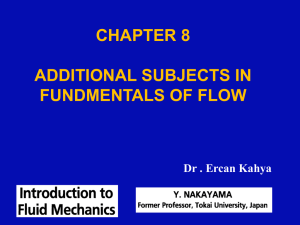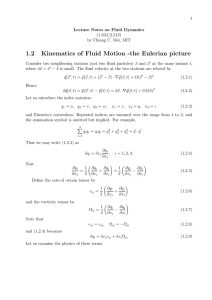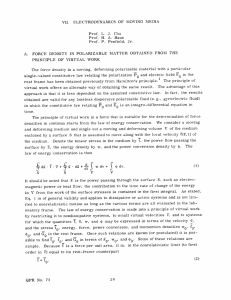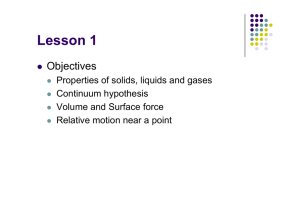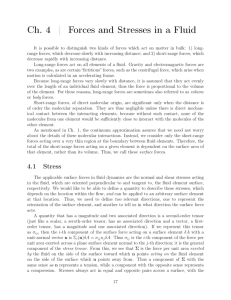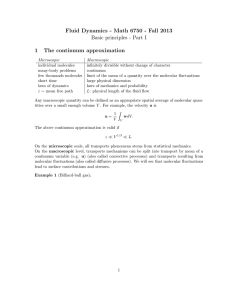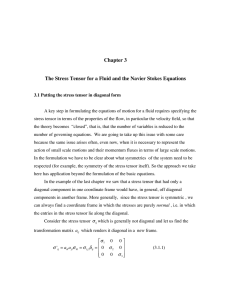Problem Set 3 18.355, Fall 2014 Due Oct. 8
advertisement
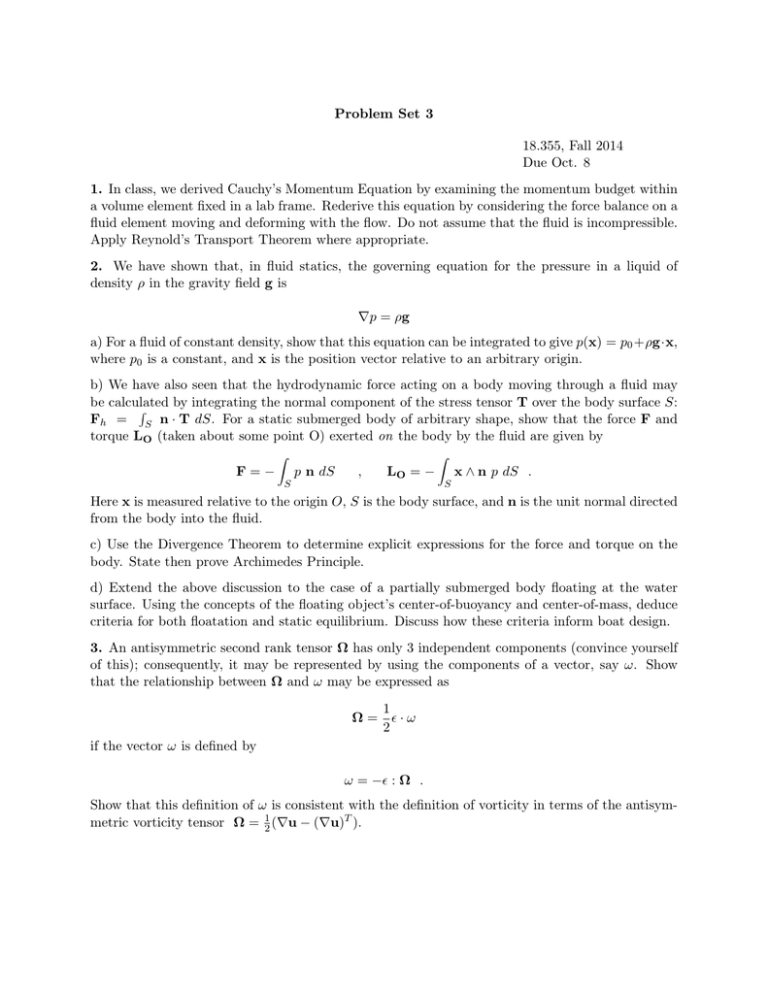
Problem Set 3 18.355, Fall 2014 Due Oct. 8 1. In class, we derived Cauchy’s Momentum Equation by examining the momentum budget within a volume element fixed in a lab frame. Rederive this equation by considering the force balance on a fluid element moving and deforming with the flow. Do not assume that the fluid is incompressible. Apply Reynold’s Transport Theorem where appropriate. 2. We have shown that, in fluid statics, the governing equation for the pressure in a liquid of density ρ in the gravity field g is ∇p = ρg a) For a fluid of constant density, show that this equation can be integrated to give p(x) = p0 +ρg·x, where p0 is a constant, and x is the position vector relative to an arbitrary origin. b) We have also seen that the hydrodynamic force acting on a body moving through a fluid may be calculated by integrating the normal component of the stress tensor T over the body surface S: R Fh = S n · T dS. For a static submerged body of arbitrary shape, show that the force F and torque LO (taken about some point O) exerted on the body by the fluid are given by F=− Z p n dS , LO = − S Z x ∧ n p dS . S Here x is measured relative to the origin O, S is the body surface, and n is the unit normal directed from the body into the fluid. c) Use the Divergence Theorem to determine explicit expressions for the force and torque on the body. State then prove Archimedes Principle. d) Extend the above discussion to the case of a partially submerged body floating at the water surface. Using the concepts of the floating object’s center-of-buoyancy and center-of-mass, deduce criteria for both floatation and static equilibrium. Discuss how these criteria inform boat design. 3. An antisymmetric second rank tensor Ω has only 3 independent components (convince yourself of this); consequently, it may be represented by using the components of a vector, say ω. Show that the relationship between Ω and ω may be expressed as 1 Ω= ·ω 2 if the vector ω is defined by ω = − : Ω . Show that this definition of ω is consistent with the definition of vorticity in terms of the antisymmetric vorticity tensor Ω = 12 (∇u − (∇u)T ). 4. Calculate the velocity gradient tensor ∇u, the rate of strain tensor E = 12 (∇u + (∇u)T ) and the vorticity tensor Ω = 21 (∇u − (∇u)T ), and the vorticity vector ω for: a) simple shear flow: ux = Gy, uy = 0 and uz = 0. b) two-dimensional extensional flow: ux = Gx, uy = −Gy and uz = 0. Sketch the velocity fields in each case. (Note that G is referred to as the shear rate). 5. In class, we deduced the heat equation from the thermal energy equation for the special case of an ideal gas. a) Do likewise for the case of a common incompressible fluid such as water. b) Use this heat equation to estimate how long it takes your Vitamix to turn chilled gazpacho into boiling soup. Assume there is no heat loss from the blender. (Relevant water properties: viscosity ν = 0.01 cm2 /s; heat capacity Cp = 4 Joules/g ◦ K; density ρ = 1 g/cc). c) If the equivalent energy were put into gravitational potential energy, roughly how high could you lift yourself? 6. In class, we saw the Cocktail Boat, which propels itself along the fluid surface by leaking alcohol off its stern. Given that alcohol reduces the surface tension of an air-water interface (∼ 70 dynes/cm) by approximately 50%, rationalize the observed boat speed.


